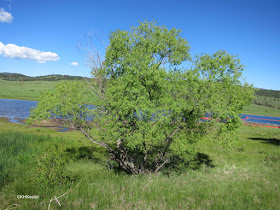From a distance it looked like rather dull grassland
because although grasses have flowers, they don't receive much admiration since they're not bright colored, sweet smelling or curiously shaped.
 |
| The grass, timothy, Phleum pratense, was in full flower |
Grasslands have so many more grasses than any other group of plant--see second photo above, but also most of the photos--that there's a word for non-grass flowering plants in a grassland, forbs. People in forests and deserts don't need the word, but it is a very helpful term for grasslands.
Here are some of the forbs I saw in flower
 |
| silver lupine, Lupinus argenteus |
 |
| silver lupine, Lupinus argenteus |
 |
| golden banner, Thermopsis |
 |
| a vetch |
 |
| prairie mouse-ear, Cerastrium arvense |
Prairie mouse-ear, a cute, common white flower. While there are four species of Cerastrium reported from Larimer County, only one is widespread in meadows, prairie mouse-ear, Cerastrium arvense. Mouse-ear is also called mouse-ear chickweed and is in the chickweed family, Caryophyllaceae. It has five petals, so deeply divided that they look like ten.
 |
| penstemons |
Penstemons, also called beardtongues (plantain family, Plantaginaceae), flower in June. Colorado has 42 different species of Penstemon, 10 in Larimer County. Worse, they are variable, their flower colors described as "blue to purple to pink" or "pale to dark blue-tinged violet." So I cautiously identify the one above, which was quite short, maybe 6" tall, as Front Range beardtongue, Penstemon virens.
 |
| penstemon and bee-fly |
I snapped photos wildly trying to show this bee fly visiting the flowers in the above photo, pollinating. I love bee flies (family Bombylidae) because they are every day mimics. The great stories of mimicry told in university classes are from exotic locations like Java and Brazil. But looking like a dangerous animal to fool a predator occurs where ever there are animals that defend themselves by being dangerous and predators who learn to avoid them. Bees sting. We don't grab them because we don't want to be stung. Birds and other animals that eat insects learn that insects with gold and black stripes sting and don't grab bees unless they can avoid the sting. Bee flies don't sting. But they have the colors, the hairiness, the behavior, including a buzz, of a bee. If you could see it from the other side you'd see fly-like compound eyes, not bee-like eyes and here, you see one pair of wings. Bees have two pairs of wings. This insect won't sting you if you grab it. But that moment that you hesitate, thinking "bee?" gives it a moment to escape. Mimicry works. (More on bee flies link)
This penstemon was also in flower, twice the size of the ones pictured above, a different shade of purple and with silver-gray leaves. Maybe Penstemon glaber.
 |
| taller penstemon |
A third penstemon was flowering along the Pinewood Reservoir trail three days later but I don't have a photo. It was even bigger, a deep red-purple and the flowers were only on one side of the stem, suggesting Penstemon virgatus, one-side penstemon (link)
And then there was this forb:
 |
| sugarbowls, Clematis hirsutissima |
It is so distinctive that when you see it in a book, you know "that's it!" Called sugarbowls or leather flower, it is an odd clematis, not much of vine and with the bowl-like flowers. It is Clematis hirsutissima or you can call it Coriflora hirsutissima if you agree with W.A. Weber that it is too strange to be lumped into Clematis. (Buttercup family, Ranunculaceae). The species epithet, hirsutisimma... Well, hirsuta is like hirsute in English, hairy. The -isimma ending means the most, so this is the hairiest clematis.
 |
| sugarbowls, Clematis hirsutissima old flower and seed pod |
And along the path, I saw this little rose, a bit over an inch across, the plant equally small and right at ground level. It was either the prairie rose, Rosa arkansana, or the smooth rose, Rosa blanda. I should have looked at the thorn-pattern on the leaves and stems, not just snapped its photo.
Three days after I hiked, there were a dozen more plants flowering that I didn't remember seeing, some I surely wouldn't have missed. So the season rolls on. What you will see keeps changing. Go take a look!
Ackerfield, J. 2015. Flora of Colorado. BRIT Press, Fort Worth, Texas.
Bee flies, (Bombylius spp.,) a pollinator with a bad reputation. USDA Forest Service, Pollinator of the Month link
Weber, W.A. and R. C. Wittman. 2001. Colorado Flora, Eastern Slope. 3rd edition. University Press of Colorado, Boulder.
Young, H. 2014. Wildflowers and Other Plants of the Larimer County Foothills Region. Larimer County Natural Resources, Fort Collins.
Comments and corrections welcome.
ReferencesAckerfield, J. 2015. Flora of Colorado. BRIT Press, Fort Worth, Texas.
Bee flies, (Bombylius spp.,) a pollinator with a bad reputation. USDA Forest Service, Pollinator of the Month link
Weber, W.A. and R. C. Wittman. 2001. Colorado Flora, Eastern Slope. 3rd edition. University Press of Colorado, Boulder.
Young, H. 2014. Wildflowers and Other Plants of the Larimer County Foothills Region. Larimer County Natural Resources, Fort Collins.
Kathy Keeler, A Wandering Botanist
More at awanderingbotanist.com



No comments:
Post a Comment